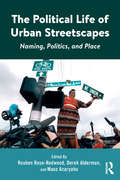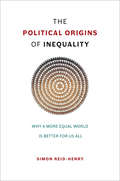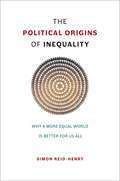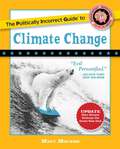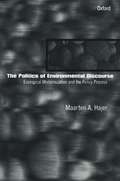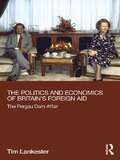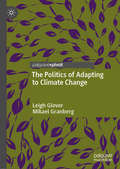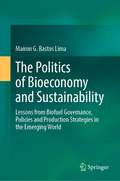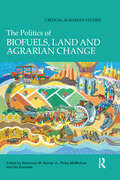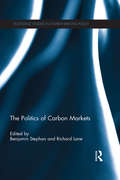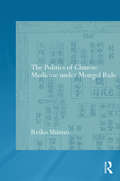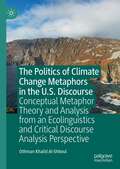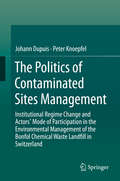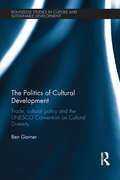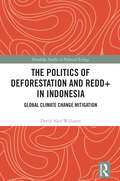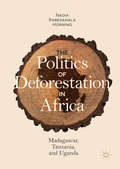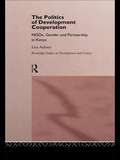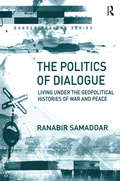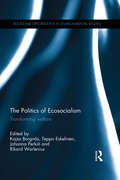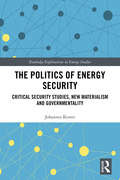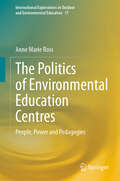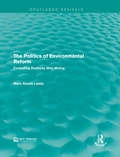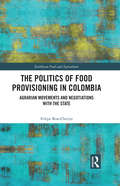- Table View
- List View
The Political Life of Urban Streetscapes: Naming, Politics, and Place
by Maoz Azaryahu Reuben Rose-Redwood Derek AldermanStreetscapes are part of the taken-for-granted spaces of everyday urban life, yet they are also contested arenas in which struggles over identity, memory, and place shape the social production of urban space. This book examines the role that street naming has played in the political life of urban streetscapes in both historical and contemporary cities. The renaming of streets and remaking of urban commemorative landscapes have long been key strategies that different political regimes have employed to legitimize spatial assertions of sovereign authority, ideological hegemony, and symbolic power. Over the past few decades, a rich body of critical scholarship has explored the politics of urban toponymy, and the present collection brings together the works of geographers, anthropologists, historians, linguists, planners, and political scientists to examine the power of street naming as an urban place-making practice. Covering a wide range of case studies from cities in Europe, North America, Sub-Saharan Africa, and Asia, the contributions to this volume illustrate how the naming of streets has been instrumental to the reshaping of urban spatial imaginaries and the cultural politics of place.
The Political Origins of Inequality
by Simon Reid-HenryInequality is the defining issue of our time. But it is not just a problem for the rich world. It is the global 1% that now owns fully half the world's wealth--the true measure of our age of inequality. In this historical tour de force, Simon Reid-Henry rewrites the usual story of globalization and development as a story of the management of inequality. Reaching back to the eighteenth century and around the globe, The Political Origins of Inequality foregrounds the political turning points and decisions behind the making of today's uneven societies. As it weaves together insights from the Victorian city to the Cold War, from US economic policy to Europe's present migration crisis, a true picture emerges of the structure of inequality itself. The problem of inequality, Reid-Henry argues, is a problem that manifests between places as well as over time. This is one reason why it cannot be resolved by the usual arguments of left versus right, bound as they are to the national scale alone. Most of all, however, it is why the level of inequality that confronts us today is indicative of a more general crisis in political thought. Modern political discourse has no place for public reason or the common good. Equality is yesterday's dream. Yet the fact that we now accept such a world--a world that values security over freedom, special treatment over universal opportunity, and efficiency over fairness--is ultimately because we have stopped even trying in recent decades to build the political architecture the world actually requires. Our politics has fallen out of step with the world, then, and at the every moment it is needed more than ever. Yet it is within our power to address this. Doing so involves identifying and then meeting our political responsibilities to others, not just offering them the selective charity of the rich. It means looking beyond issues of economics and outside our national borders. But above all it demands of us that we reinvent the language of equality for a modern, global world: and then institute this. The world is not falling apart. Different worlds, we all can see, are colliding together. It is our capacity to act in concert that is falling apart. It is this that needs restoring most of all.
The Political Origins of Inequality: Why a More Equal World Is Better for Us All
by Simon Reid-HenryInequality is the defining issue of our time. But it is not just a problem for the rich world. It is the global 1% that now owns fully half the world’s wealth—the true measure of our age of inequality. In this historical tour de force, Simon Reid-Henry rewrites the usual story of globalization and development as a story of the management of inequality. Reaching back to the eighteenth century and around the globe, The Political Origins of Inequality foregrounds the political turning points and decisions behind the making of today’s uneven societies. As it weaves together insights from the Victorian city to the Cold War, from US economic policy to Europe’s present migration crisis, a true picture emerges of the structure of inequality itself. The problem of inequality, Reid-Henry argues, is a problem that manifests between places as well as over time. This is one reason why it cannot be resolved by the usual arguments of left versus right, bound as they are to the national scale alone. Most of all, however, it is why the level of inequality that confronts us today is indicative of a more general crisis in political thought. Modern political discourse has no place for public reason or the common good. Equality is yesterday’s dream. Yet the fact that we now accept such a world—a world that values security over freedom, special treatment over universal opportunity, and efficiency over fairness—is ultimately because we have stopped even trying in recent decades to build the political architecture the world actually requires. Our politics has fallen out of step with the world, then, and at the every moment it is needed more than ever. Yet it is within our power to address this. Doing so involves identifying and then meeting our political responsibilities to others, not just offering them the selective charity of the rich. It means looking beyond issues of economics and outside our national borders. But above all it demands of us that we reinvent the language of equality for a modern, global world: and then institute this. The world is not falling apart. Different worlds, we all can see, are colliding together. It is our capacity to act in concert that is falling apart. It is this that needs restoring most of all.
The Politically Incorrect Guide to Climate Change (The\politically Incorrect Guides)
by Marc MoranoLess freedom. More regulation. Higher costs. Make no mistake: those are the surefire consequences of the modern global warming campaign waged by political and cultural elites, who have long ago abandoned fact-based science for dramatic fearmongering in order to push increased central planning. The Politically Incorrect Guide to Climate Change gives a voice -- backed by statistics, real-life stories, and incontrovertible evidence -- to the millions of "deplorable" Americans skeptical about the multibillion dollar "climate change" complex, whose claims have time and time again been proven wrong.
The Politics Of Environmental Discourse: Ecological Modernization And The Policy Process
by Maarten A. HajerDr Hajer's path-breaking study opens the way for a better understanding of the environmental conflict, showing how language can be seen to shape our view of what environmental politics is really about and how those perceptions can differ between countries. The author identifies the emergence and increasing political importance of 'ecological modernization' as a new concept in the language of environmental politics. This concept, which has come to replace the antagonistic debates of the 1970s, stresses the opportunities of environmental policy for modernizing the economy and stimulating the technological innovation. Combining abstract social theory with detailed empirical analysis, Martin Hajer illustrates the social and political dynamics of ecological modernization in a detailed analysis of the acid rain controversies in Great Britain and the Netherlands. He concludes by reflecting on the institutional challenge of the environmental politics in the years to come.
The Politics and Economics of Britain's Foreign Aid: The Pergau Dam Affair (Routledge Explorations in Development Studies)
by Tim LankesterThe Pergau dam in Malaysia was the most controversial project in the history of British aid. Because of its high cost, it was a poor candidate for aid funding. It was provided in part to honour a highly irregular promise of civil aid in connection with a major arms deal. After two parliamentary inquiries and intense media coverage, in a landmark judgement the aid for Pergau was declared unlawful. Tim Lankester offers a detailed case study of this major aid project and of government decision-making in Britain and Malaysia. Exposing the roles played by key politicians and other stakeholders on both sides, he analyses the background to the aid/arms linkage, and the reasons why the British and Malaysian governments were so committed to the project, before exploring the response of Britain’s Parliament, and its media and NGOs, and the resultant legal case. The main causes of the Pergau debacle are carefully drawn out, from conflicting policy agendas within the British government to the power of the business lobby and the inability of Parliament to provide any serious challenge. Finally, Lankester asks whether, given what was known at the time and what we know now, he and his colleagues in Britain’s aid ministry were correct in their objections to the project. Pergau is still talked about as a prime example of how not to do aid. Tim Lankester, a key figure in the affair, is perfectly placed to provide the definitive account. At a time when aid budgets are under particular scrutiny, it provides a cautionary tale.
The Politics of Adapting to Climate Change
by Mikael Granberg Leigh GloverThis book examines the political themes and policy perspectives related to, and influencing, climate change adaptation. It provides an informed primer on the politics of adaptation, a topic largely overlooked in the current scholarship and literature, and addresses questions such as why these politics are so important, what they mean, and what their implications are. The book also reviews various political texts on adaptation.
The Politics of Bioeconomy and Sustainability: Lessons from Biofuel Governance, Policies and Production Strategies in the Emerging World
by Mairon G. Bastos LimaThis book addresses the underexposed political dimensions of bioeconomy promotion. Who wins and who loses? How are institutions being shaped, and by whom? Drawing from experiences since the earlier days of biofuels promotion, it explores in unprecedented detail the global drive away from fossil fuels and towards a biomass-based economy.Multipurpose agriculture gains ever more traction as countries create new bio-based value chains – or, rather, value webs. Governance, in this regard, proves to be key for steering developments towards inclusive agri-food-biomass systems instead of fueling just a handful of “flex crops” ridden with social equity and other environmental issues.Based on a rich global-level analysis of bioeconomy promotion and three in-depth case studies of key emerging economies (Brazil, India and Indonesia), the book also innovatively examines sustainability politics in Global South democracies.Ultimately, this book is about finding the politics for a fairer bioeconomy in the years and decades to come.
The Politics of Biofuels, Land and Agrarian Change (Critical Agrarian Studies)
by Ian Scoones Philip McMichael Saturnino M. BorrasThis book addresses key questions on biofuels within agrarian political economy, political sociology and political ecology. Contributions are based on fresh empirical materials from different parts of the world. The book starts with four key questions in agrarian political economy: Who owns what? Who does what? Who gets what? And what do they do with the surplus wealth? It also addresses the emergent social and political relations in the biofuel complex and, given the impacts on natural resources and sustainability, engages with questions about people-environment interactions. At the same time, the book is concerned with the politics of representation, that is, what are the discursive frames through which biofuels are promoted and/or opposed?The book analyses the institutional structures, and cultures of energy consumption on which a biofuels complex depends, and the alternative political and ecological visions emerging that call the biofuels complex into question. Across sixteen chapters presenting material from five regions across the North-South divide and focusing on fourteen countries including Brazil, Indonesia, India, USA and Germany, these topics are addressed within the following themes: global (re)configurations; agro-ecological visions; conflicts, resistances and diverse outcomes; state, capital and society relations; mobilising opposition, creating alternatives; and change and continuity.This book was published as a special issue of the Journal of Peasant Studies.
The Politics of Carbon Markets (Routledge Studies in Environmental Policy)
by Richard Lane Benjamin StephanThe carbon markets are in the middle of a fundamental crisis - a crisis marked by collapsing prices, fleeing actors, and ever increasing greenhouse gas levels. Yet carbon trading remains at the heart of global attempts to respond to climate change. Not only this, but markets continue to proliferate - particularly in the Global South. The Politics of Carbon Markets helps to make sense of this paradox and brings two urgently needed insights to the analysis of carbon markets. First, the markets must be understood in relation to the politics involved in their development, maintenance and opposition. Second, this politics is multiform and pervasive. Implementation of new techniques and measuring tools, policy development and contestation, and the structuring context of institutional settings and macro-social forces all involve a variety of political actors and create new forms of political agency. The contributions study the total extent of the carbon markets, from their prehistory to their contemporary expansion and wider impacts. This wide-ranging political perspective on the carbon markets is invaluable to those studying and interested in ecological markets, climate change governance and environmental politics.
The Politics of Chinese Medicine Under Mongol Rule (Needham Research Institute Series)
by Reiko ShinnoUnder the rule of the descendants of Chinggis Khan (1167-1227), China saw the development of a new culture in which medical practice came to be considered a highly respected occupation for elite men. During this period, further major steps were also taken towards the codification of medical knowledge and promotion of physicians’ social status. This book traces the history of the politics, institutions, and culture of medicine of China under Mongol rule, through the eyes of a successful South Chinese official Yuan Jue (1266-1327). As the first comprehensive monograph on history of medicine in China under the Mongols, it argues that this period was a separate moment in Chinese history, when a configuration of power different from that of previous and succeeding periods created its own medical culture. The Politics of Chinese Medicine under Mongol Rule emphasizes the impact of the political and institutional changes caused by the Mongols and their collaborators on the social and cultural history of medicine, which culminated in the medical theory of Zhu Zhenheng (1282–1358), still influential in East Asian medicine. Using a variety of Chinese-language sources including gazetteers, legal texts, biographies, poems, and medical texts, it analyses the roles of the Mongols and West and Central Asians as cultural brokers and also as unifiers of China. Further, it views North and South Chinese elites as agents of historical change rather than as victims of Mongol oppression. Underlining the complexity of the history of China under the Mongols and the significance of time and geography for the study of this history, this book will be of great interest to students and scholars of Chinese medical history, Chinese social and cultural history, and medieval global history.
The Politics of Climate Change Metaphors in the U.S. Discourse: Conceptual Metaphor Theory and Analysis from an Ecolinguistics and Critical Discourse Analysis Perspective
by Othman Khalid Al-ShboulThis book uses critical metaphor analysis to show from a cognitive perspective how climate change is conceptualized in the USA. The author enriches his linguistic analysis with cognitive aspects such as source-target domain mapping and metaphor opposition to explain how metaphor works in terms of framing this issue, drawing on a Critical Discourse Analysis-informed framework to demonstrate how politicians represent the climate crisis in their attempts to trigger social change. Using a data set of speeches given by US-based politicians, governors and mayors speaking in the context of the withdrawal of the United States from the Paris Agreement, the book categorizes metaphors on different conceptions such as war, construction, unfairness, journey, and cleanliness to bridge the gap between ecolinguistics and critical metaphor analysis. This book will be of interest to students and scholars in fields including applied linguistics, political communication, ecolinguistics, and cognitive linguistics and psychology.
The Politics of Climate Change and Uncertainty in India (Pathways to Sustainability)
by Lyla MehtaThis book brings together diverse perspectives concerning uncertainty and climate change in India. Uncertainty is a key factor shaping climate and environmental policy at international, national and local levels. Climate change and events such as cyclones, floods, droughts and changing rainfall patterns create uncertainties that planners, resource managers and local populations are regularly confronted with. In this context, uncertainty has emerged as a "wicked problem" for scientists and policymakers, resulting in highly debated and disputed decision-making. The book focuses on India, one of the most climatically vulnerable countries in the world, where there are stark socio-economic inequalities in addition to diverse geographic and climatic settings. Based on empirical research, it covers case studies from coastal Mumbai to dryland Kutch and the Sundarbans delta in West Bengal. These localities offer ecological contrasts, rural–urban diversity, varied exposure to different climate events, and diverse state and official responses. The book unpacks the diverse discourses, practices and politics of uncertainty and demonstrates profound differences through which the "above", "middle" and "below" understand and experience climate change and uncertainty. It also makes a case for bringing together diverse knowledges and approaches to understand and embrace climate-related uncertainties in order to facilitate transformative change. Appealing to a broad professional and student audience, the book draws on wide-ranging theoretical and conceptual approaches from climate science, historical analysis, science, technology and society studies, development studies and environmental studies. By looking at the intersection between local and diverse understandings of climate change and uncertainty with politics, culture, history and ecology, the book argues for plural and socially just ways to tackle climate change in India and beyond.
The Politics of Contaminated Sites Management
by Johann Dupuis Peter KnoepfelBy the end of the 1970s, contaminated sites had emerged as one of the most complex and urgent environmental issues affecting industrialized countries. The authors show that small and prosperous Switzerland is no exception to the pervasive problem of sites contamination, the legacy of past practices in waste management having left some 38,000 contaminated sites throughout the country. This book outlines the problem, offering evidence that open and polycentric environmental decision-making that includes civil society actors is valuable. They propose an understanding of environmental management of contaminated sites as a political process in which institutions frame interactions between strategic actors pursuing sometimes conflicting interests. In the opening chapter, the authors describe the influences of politics and the power relationships between actors involved in decision-making in contaminated sites management, which they term a "wicked problem. " Chapter Two offers a theoretical framework for understanding institutions and the environmental management of contaminated sites. The next five chapters present a detailed case study on environmental management and contaminated sites in Switzerland, focused on the Bonfol Chemical Landfill. The study and analysis covers the establishment of the landfill under the first generation of environmental regulations, its closure and early remediation efforts, and the gambling on the remediation objectives, methods and funding in the first decade of the 21st Century. The concluding chapter discusses the question of whether the strength of environmental regulations, and the type of interactions between public, private, and civil society actors can explain the environmental choices in contaminated sites management. Drawing lessons from research, the authors debate the value of institutional flexibility for dealing with environmental issues such as contaminated sites.
The Politics of Cultural Development: Trade, cultural policy and the UNESCO Convention on Cultural Diversity (Routledge Studies in Culture and Sustainable Development)
by Ben GarnerThere is a growing recognition of the role that culture can play in sustainable development strategies. This development has generally been welcomed, but also raises a number of questions: What are the implications in policy and practice? Who are the most influential voices in promoting a global agenda for culture and development, and to what extent has the creation of new international policy instruments reflected a consensus? More fundamentally, what is meant by "culture" in these discussions and who has the power to give particular definitions political and legal authority? The Politics of Cultural Development seeks to provide a theoretically and historically informed response to such questions, illustrated by reference to case studies (including the European Union, the Caribbean and China). Particular attention is paid to the formation of the UNESCO Convention on the Protection and the Promotion of the Diversity of Cultural Expressions, a landmark instrument in debates about culture and development. The book goes on to explore some of the practical implications that this international treaty is beginning to have for the ways that culture is (and is not) being integrated into contemporary development policy and practice. This book will be useful for students, academics and policymakers in the fields of international development, international relations, international political economy, cultural policy and cultural theory.
The Politics of Deforestation and REDD+ in Indonesia: Global Climate Change Mitigation (Routledge Studies in Political Ecology)
by David Aled WilliamsThis book reflects on Indonesia’s recent experience with REDD+ (Reducing Emissions from Deforestation and forest Degradation), all set within a broader discussion of neoliberal environmentalism, hyper-capitalism, and Indonesian carbon politics. Drawing on the author’s political ethnographic fieldwork conducted in Jakarta, Central Sulawesi, and Oslo, where the author examined Norway’s interests and role in implementing REDD+, this book discusses the long evolution of the idea that foreign state and private financing can be used to protect tropical forests and the carbon stored within them, resulting in both local economic development and global climate benefits. It shows how neoliberal environmental approaches to climate change, of which REDD+ is a leading example, increase the severity of political contestations that must be overcome to reach global climate mitigation goals, and how recent incarnations of REDD+ have tended to forget earlier scholarly advice to couple anti-deforestation approaches with policies that reduce industrial carbon emissions. In Indonesia, tectonic political and economic forces are shown to have negatively impacted REDD+ implementation. Using a political ecology approach, the book links the literature on REDD+ with that covering Indonesia’s recent democratic regression, highlighting how the country’s environmental performance is inextricably linked to the timbre of its political governance. Given the severity of the political contestations that must be overcome to reach its stated goals, REDD+ cannot replace global policies that drastically reduce industrial carbon emissions. This book will be of great interest to students and scholars of political ecology, deforestation, climate change, environmental politics, natural resource management, and environmental conservation.
The Politics of Deforestation in Africa: Madagascar, Tanzania, And Uganda
by Nadia Rabesahala HorningThis book explores how environmental policies are made and enforced in Africa. Specifically, this project explains the gap between intent and impact of forest policies, focusing on three African societies facing persistent deforestation today: Madagascar, Tanzania, and Uganda. The central claim of the study is that deforestation persists because conservation policies and projects, which are largely underwritten by foreign donors, consistently ignore the fact that conservation is possible only under limited and specific conditions. To make the case, the author examines how decision-making power is negotiated and exercised where communities make environmental decisions daily (local level) and where environmental policies are negotiated and enacted (national level) across three distinct African political systems.
The Politics of Development Co-operation: NGOs, Gender and Partnership in Kenya (Routledge Studies in Development and Society)
by Lisa AubreyFirst Published in 2004. Routledge is an imprint of Taylor & Francis, an informa company.
The Politics of Dialogue: Living Under the Geopolitical Histories of War and Peace (Border Regions Series)
by Ranabir SamaddarOffering a detailed analysis of post-colonial South Asia, The Politics of Dialogue discusses the creation and impact of borders and the pervasive tension between the new nations. Neither all-out war nor complete peace, this fragile condition makes political leaders and strategists feel claustrophobic - a war produces an end result but peace allows the rulers to carry out their policies for governing along their preferred path of development. The book shows how cartographic, communal and political lines are not only dividing countries, but that they are being replicated within countries, creating new visible and invisible internal frontiers. It argues that, in a situation where geopolitics constrains democracy, the political class becomes incapable of coping with the tension between the inside/outside, eg democracy appears as an internal problem and geopolitics appears as a problem related to the 'outside'.
The Politics of Ecosocialism: Transforming welfare (Routledge Explorations in Environmental Studies)
by Kajsa Borgnäs Teppo Eskelinen Johanna Perkiö Rikard WarleniusAs the global economy seeks to recover from the financial crisis and warnings about the consequences of climate change abound, it is clear that we need a fundamentally new approach to tackle these issues. This innovative book offers a unique perspective, stressing the necessity of both ecological and social change as it discusses how to create a "red-green" or "eco-socialist" society. Examining the current crises of welfare capitalism as well as the challenges and conflicts of an eco-socialist society, the book proposes a new social order that would combine the ideals of egalitarianism and of environmental sustainability. It analyses the key social and ecological issues related to the welfare state, including green Keynesianism, ecological Marxism, the limits of growth and no-growth, capitalist barriers to a renewable energy transition, proposals for a universal basic income and the role of technology. Finally, the book outlines possible paths of transformation towards creating an eco-socialist society, drawing out lessons that can be applied internationally. This book will be of great interest to students and researchers in economics, environmental studies and political science.
The Politics of Energy Security: Critical Security Studies, New Materialism and Governmentality (Routledge Explorations in Energy Studies)
by Johannes KesterEnergy security is known for its ‘slippery’ nature and subsequent broad range of definitions. Instead of another attempt to grasp its essence, this book offers a critical reflection that problematizes the use of energy security itself. After a short historical and methodological analysis of the proliferation of energy security, The Politics of Energy Security unpacks three social practices that drive energy security. These include an analysis of the logics of security, a study of the relation between the materiality of sociotechnical (energy) systems and the knowledge people have over such systems, and a reflection on the power and politics behind (energy) security. Each of these are discussed and ultimately illustrated in the last chapter to show how energy security works, how it is shaped and what role it plays within political processes. Based on a novel performative reading of energy security with its focus on ontological politics and an in-depth look at the often implicitly accepted social practices that determine how people shape and are shaped by energy security, this book will be of great interest to students and scholars of energy security and policy, political theory, international relations, critical security studies, and environmental studies more broadly.
The Politics of Environmental Education Centres: People, Power and Pedagogies (International Explorations in Outdoor and Environmental Education #17)
by Anne Marie RossThis book juxtaposes a representation of environmental education centres around the globe with centres within the New South Wales Department of Education in Australia. As terminology shifted from nature study and conservation education to environmental education then “environmental and sustainability education” within “sustainable development” the centres embodied and encompassed this evolution. The book traces the centres’ journeys through the phenomenon of the 1970s growth in socially conscious governance, to 1980s-1990s public managerialism, to the tightening tentacles of capitalism. The complexity of education as a socio-political endeavour is made explicit. Themes including the changing dynamics of caring for the environment, and bureaucratic and political manoeuvring, in addition to the effects of activism and globalisation are viewed through a centre lens as the centres survive and thrive in ever increasing neoliberal times. The book will appeal to teachers, academics and bureaucrats interested in the history and politics of environmental education.
The Politics of Environmental Performance
by Detlef JahnAs the world faces the prospect of climate change, nuclear disasters, and water scarcity, it is clear that environmental degradation is an increasingly serious challenge with economic and social consequences. In this book, Detlef Jahn analyzes political processes in a macro-comparative study in order to estimate the role of politics in the field of environmental performance in twenty-one OECD countries. His model demonstrates various styles of politics used to combat environmental degradation. He finds that economic and environmental performance are still closely linked, and that moving towards a service society does not by itself solve the environmental challenge. The close relationship of these areas was made strikingly clear in the economic crisis of the new millennium. He argues that economic globalization fosters environmental deterioration, and undermines efforts in domestic politics and international coordination to improve the environmental record.
The Politics of Environmental Reform: Controlling Kentucky Strip Mining (Routledge Revivals)
by Marc Karnis LandyThe Politics of Environmental Reform demonstrates how environmental laws affect local governments with Kentucky strip mining as its core example. Originally published in 1976, Landy’s research into environmental legislation in a state whose economy relies on the coal industry can easily be applied to all forms of government shedding light on issues such as policy initiation, federal-state relations and regulatory performance. This title will be of interest to students of Environmental Studies and professionals.
The Politics of Food Provisioning in Colombia: Agrarian Movements and Negotiations with the State (Earthscan Food and Agriculture)
by Felipe Roa-ClavijoThis book explores food provisioning in Colombia by examining the role and impact of the agrarian negotiations which took place in the aftermath of the 2013–2014 national strikes. Most of the research in the field of agrarian studies in Colombia has focused on inequalities in land distribution, the impacts of violent conflict, and most recently, the first phase of the peace agreement implementation. This book links and complements these literatures by critically engaging with an original framework that uncovers the conflicts and politics of food provisioning: who produces what and where, and with what socio-economic effects. This analytical lens is used to explain the re-emergence of national agrarian movements, their contestation of the dominant development narratives and their engagement in discussions about food sovereignty with the state. The analysis incorporates a wide range of voices from high-level government representatives and leaders from national agrarian movements. Their narratives of food provisioning and the broader role of the food industry are reviewed and the key findings show an underlying conflict within food provisioning based on the struggle of marginalised smallholders to develop alternative agri-food systems that can be included in the local and domestic food markets in the context of a state dominated by an export and import approach. Overall, the book argues that the battle ground of agrarian conflicts has moved to the fi eld of food provisioning and using this approach has the potential to reframe the debate about the future of food and agriculture in Colombia and beyond. This book will be of great interest to students and scholars of food and agriculture, rural development, peasant studies, and Latin American Studies.
